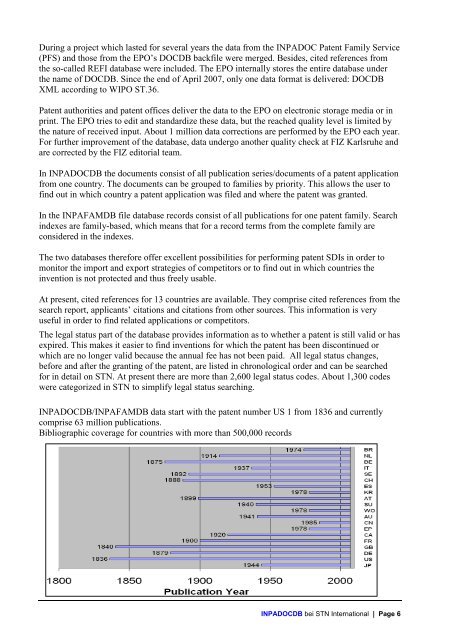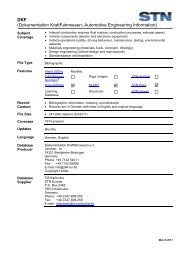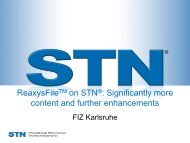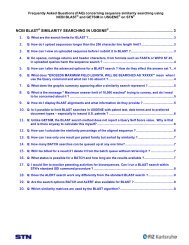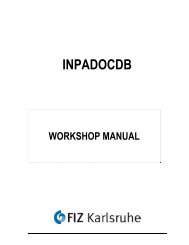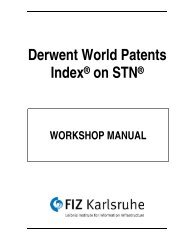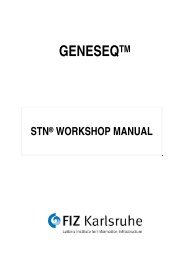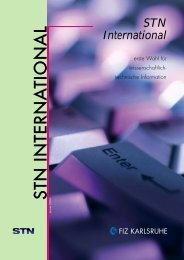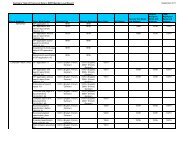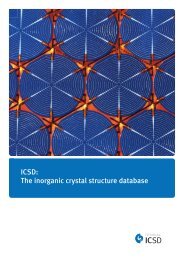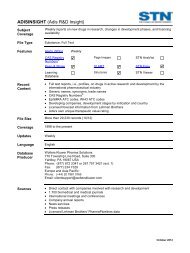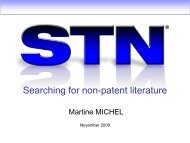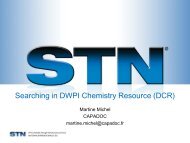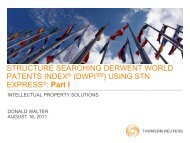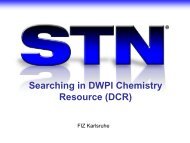- Page 1 and 2: INPADOCDB The International Patent
- Page 3 and 4: TABLE OF CONTENTS - 1 - CONTENTS CO
- Page 5 and 6: Introduction This handbook is suppo
- Page 7: DOCDB THE INPADOCDB/INPAFAMDB DATAB
- Page 11 and 12: educed pressure. Further developmen
- Page 13 and 14: AI DE 1999-19928770 A 19990623 AIO
- Page 15 and 16: AIO 19928770 AIT DEA Patent applica
- Page 17 and 18: Document structure in INPAFAMDB In
- Page 19 and 20: Which file to choose, INPADOCDB or
- Page 21 and 22: Abstract At present, the database c
- Page 23 and 24: Search Question: Search for the abo
- Page 25 and 26: 243475 LASER (LASER OR LASERS) 6529
- Page 27 and 28: Expand with and without left trunca
- Page 29 and 30: Classifications International Paten
- Page 31 and 32: IPC Classification concepts Old con
- Page 33 and 34: Reclassification Reference database
- Page 35 and 36: Search with Core Level Codes The ne
- Page 37 and 38: => D IPC IPCI H01L0021-8247 [I,A];
- Page 39 and 40: 5 144 144 2.29 A01N0025-30 6 104 10
- Page 41 and 42: CORE VALID FROM 19900101 TO PRESENT
- Page 43 and 44: Example: Identification of relevant
- Page 45 and 46: European Patent Classifications (EP
- Page 47 and 48: AN 52907135 INPADOCDB ED 20071102 E
- Page 49 and 50: IPCI H04J0011-00 [I,A]; H04B0001-70
- Page 51 and 52: E10 2 C10G0009-00+X1X3Z/EPC E11 3 C
- Page 53 and 54: The ICO Classification (ECLA K-Y; I
- Page 55 and 56: National Patent Classification (NCL
- Page 57 and 58: Applicant and inventor names NAME S
- Page 59 and 60:
It is recommended to search for inv
- Page 61 and 62:
200713.............................
- Page 63 and 64:
Address information Depending on th
- Page 65 and 66:
Super search fields In INPADOCDB an
- Page 67 and 68:
PIT USA1 FIRST PUBLISHED PATENT APP
- Page 69 and 70:
SEARCH FOR NUMBERS AND DATES Patent
- Page 71 and 72:
Changing patent number formats The
- Page 73 and 74:
DE 19919951A1 => S DE19919951/PN EP
- Page 75 and 76:
2. Hungary, Lithuania, Monaco: Also
- Page 77 and 78:
=> E JP 2139594/PN E154 1 JP2119394
- Page 79 and 80:
Application and priority numbers Th
- Page 81 and 82:
Kind of Documents Each INPADOCDB/IN
- Page 83 and 84:
PUBLICATION [FROM 2001 ONWARDS] DAV
- Page 85 and 86:
unexamined-not-printed-withoutgrant
- Page 87 and 88:
The “Filing Details” (FDT) fiel
- Page 89 and 90:
In 2003 WIPO changed the FDT codes
- Page 91 and 92:
Country designations All country de
- Page 93 and 94:
Dates Several date specifications a
- Page 95 and 96:
CITATION SEARCH Citations are as im
- Page 97 and 98:
FA AB; AI; AN; DAV; DS; DT; ED; EPC
- Page 99 and 100:
Patent Country US EP WO Publ. Year
- Page 101 and 102:
The SRT field indicates the origin
- Page 103 and 104:
=> E A/CAT **** START OF FIELD ****
- Page 105 and 106:
Family display INPADOCDB INPADOCDB
- Page 107 and 108:
EFAM.PRD Priority Date The followin
- Page 109 and 110:
Display format FAM DISPLAY FAM is a
- Page 111 and 112:
AI DE 2000-20004953 U 20000310 AIT
- Page 113 and 114:
DS R: DE ES FR GB SE AI EP 2001-919
- Page 115 and 116:
PAS TAKATA PETRI AG DT Patent PI ES
- Page 117 and 118:
EPC B60Q0005-00S2; H01H0001-18 FA A
- Page 119 and 120:
+--------------AI--------------+ +-
- Page 121 and 122:
DE 2000-20004953 U 20000310 (DEU) P
- Page 123 and 124:
WO 2001-DE1024 W 20010312;DE 2001-5
- Page 125 and 126:
another for actuating the electric
- Page 127 and 128:
=> S LASER AND PROTOTYPING; D ALL.H
- Page 129 and 130:
C04B0035-634B8; C04B0035-634D10; B2
- Page 131 and 132:
INPAFAMDB: Display of basic patent
- Page 133 and 134:
FSEARCH and FSORT The commands FSEA
- Page 135 and 136:
=> D PFAM=1- 5 Multi-record Familie
- Page 137 and 138:
DE 8120 DE 8121 DE 8122 DE 8123 DE
- Page 139 and 140:
TIME-LIMIT DK: 20000719 NIF Lapses,
- Page 141 and 142:
LSDS BE DE DK FR GB IT NL SE AN 235
- Page 143 and 144:
The example illustrates which infor
- Page 145 and 146:
Search examples Search for legal st
- Page 147 and 148:
Search for legal status events Lega
- Page 149 and 150:
Search question: Search for opposit
- Page 151 and 152:
Search question: Search for SPCs of
- Page 153 and 154:
Note z Legal status information in
- Page 155 and 156:
AN 24063529 INPADOCDB ED 20070505 E
- Page 157 and 158:
Search and display field “Change
- Page 159 and 160:
Updates in INPAFAMDB In INPAFAMDB t
- Page 161 and 162:
=> D BIB UPALL AN 53039753 INPADOCD
- Page 163 and 164:
STA PRE-GRANT PUBLICATION DS R: AT
- Page 165 and 166:
The table below shows the family up
- Page 167 and 168:
L1 ANSWER 3 OF 4457 INPADOCDB COPYR
- Page 169 and 170:
Legal status monitoring with "PROXI
- Page 171 and 172:
….. . . OPEN /R read _TODAY captu
- Page 173 and 174:
PA EADS SPACE TRANSPORTATION SA PAS
- Page 175 and 176:
Online helps on proximity operators
- Page 177 and 178:
Number of records per country Statu
- Page 179 and 180:
Country Codes (/PC) and Kind Codes
- Page 181 and 182:
BE T2 PATENT OF INVENTION FROM EP I
- Page 183 and 184:
CU A ALL TYPES OF PATENT PUBLICATIO
- Page 185 and 186:
DK U4 UTILITY MODEL SPECIFICATION,
- Page 187 and 188:
FR B1 PATENT OF INVENTION (SECOND P
- Page 189 and 190:
IN A1 PATENT IN E PATENT OF ADDITIO
- Page 191 and 192:
MD A PUBLISHED NON-EXAMINED PATENT
- Page 193 and 194:
PL B2 PROVISIONAL PATENT [FROM 1980
- Page 195 and 196:
TJ B GRANTED PATENT TJ R3 REREGISTR
- Page 197 and 198:
WO A2 INTERNATIONAL PUBLICATION WIT
- Page 199 and 200:
118596 BRA PATENT APPLICATION 3231
- Page 201 and 202:
1 FIUT TECHNICAL PRIORITY 1832079 F
- Page 203 and 204:
4 LIAT TECHNICAL PRIORITY 228 LKA P
- Page 205 and 206:
1206597 SUA PATENT APPLICATION 1470
- Page 207 and 208:
STN number formats with appended co
- Page 209 and 210:
Application and priority numbers Ov
- Page 211 and 212:
CL Chile 02.03.1990 07.09.1998 CL P
- Page 213 and 214:
NZ New Zealand 29.06.2001 26.09.200
- Page 215 and 216:
WO World Intellectual Property Orga
- Page 217 and 218:
Country Code Titles in Documents in
- Page 219 and 220:
Lecco LC 993 from 1.1.97 Venezia VE
- Page 221 and 222:
Search Examples Example 1 Combined
- Page 223 and 224:
Example 2 Patent assignee search in
- Page 225 and 226:
=> s ((haensel or hansel)(s)(dietri
- Page 227 and 228:
Example 5 Completing search results
- Page 229 and 230:
L6 ANSWER 78 OF 488 INPAFAMDB COPYR
- Page 231 and 232:
Example 7 Retrieving patent family
- Page 233 and 234:
Example 8 Retrieving legal status i
- Page 235 and 236:
Example 10 Statistics (invention-ce
- Page 237 and 238:
ADVANCED VALID FROM 19680901 TO PRE
- Page 239 and 240:
=> tab dt py grid doc d alpha a L2
- Page 241 and 242:
October 2007 INPADOCDB bei STN Inte
- Page 243:
Notes: INPADOCDB bei STN Internatio


